Seat Belt & Car Seat Statistics
Find Cheap Auto Insurance Quotes in Your Area
One in 10 people don't wear seat belts in the front seat, despite estimates that seat belts saved 14,955 lives in the last year for which complete data was available. Drivers and passengers who don't buckle up account for 43% of deaths in traffic accidents.
ValuePenguin compiled a full picture of seat belts statistics in the U.S. This roundup highlights the dangers of not wearing a seat belt, who’s complying with seat belt laws and much more.
Key facts about seat belts
- 1 in 10 people don’t wear seat belts in the front seats of passenger vehicles. Experts estimate seat belts saved the lives of 14,955 people in one recent year — and could have saved 2,549 more lives that same year. Since 1975, seat belts have saved an estimated 374,376 lives.
- Drivers and passengers not wearing seat belts accounted for 43% of the deaths from car accidents in 2019. Of the 22,215 killed in road accidents in 2019, 9,466 weren't wearing a seat belt.
- People ages 16 to 24 are the least likely to wear their seat belts in the front, but their behaviors change depending on who’s in the vehicle with them. Meanwhile, women (93%) are more likely than men (88%) to wear their seat belts in the front.
- New Hampshire has the lowest seat belt usage rate — by far — at 71%. The state doesn’t require drivers 18 and older to buckle up. Hawaii has the highest seat belt usage rate at 97%.
- Experts estimate that the lives of 325 small children were saved by car seats in the most recent year for which data was available. And only 67% of drivers who don't wear a belt themselves put child passengers in car seats.
- Only 79% of drivers strap in kid passengers in light traffic — defined as less than or equal to one vehicle per lane per mile — compared with 96% in heavy traffic — defined as greater than five vehicles per lane per mile. Women (95%) are slightly more likely to strap in kids than men (93%).
Table of contents
Seat belt statistics
Only 1 in 10 people don't wear their seat belts in the front seat, according to 2020 data from the National Highway Traffic Safety Administration. Despite this somewhat low figure, of the 22,215 passenger vehicle occupants killed in 2019, 43% weren’t wearing a seat belt.
Road fatalities by restraint use
Passenger car | Light truck | Total | |
|---|---|---|---|
| Seat belt | 6,232 | 4,326 | 10,558 |
| Child car seat | 58 | 42 | 100 |
| Restraint used incorrectly | 92 | 65 | 157 |
| No seat belt | 4,794 | 4,672 | 9,466 |
| Unknown | 1,063 | 871 | 1,934 |
| Total | 12,239 | 9,976 | 22,215 |
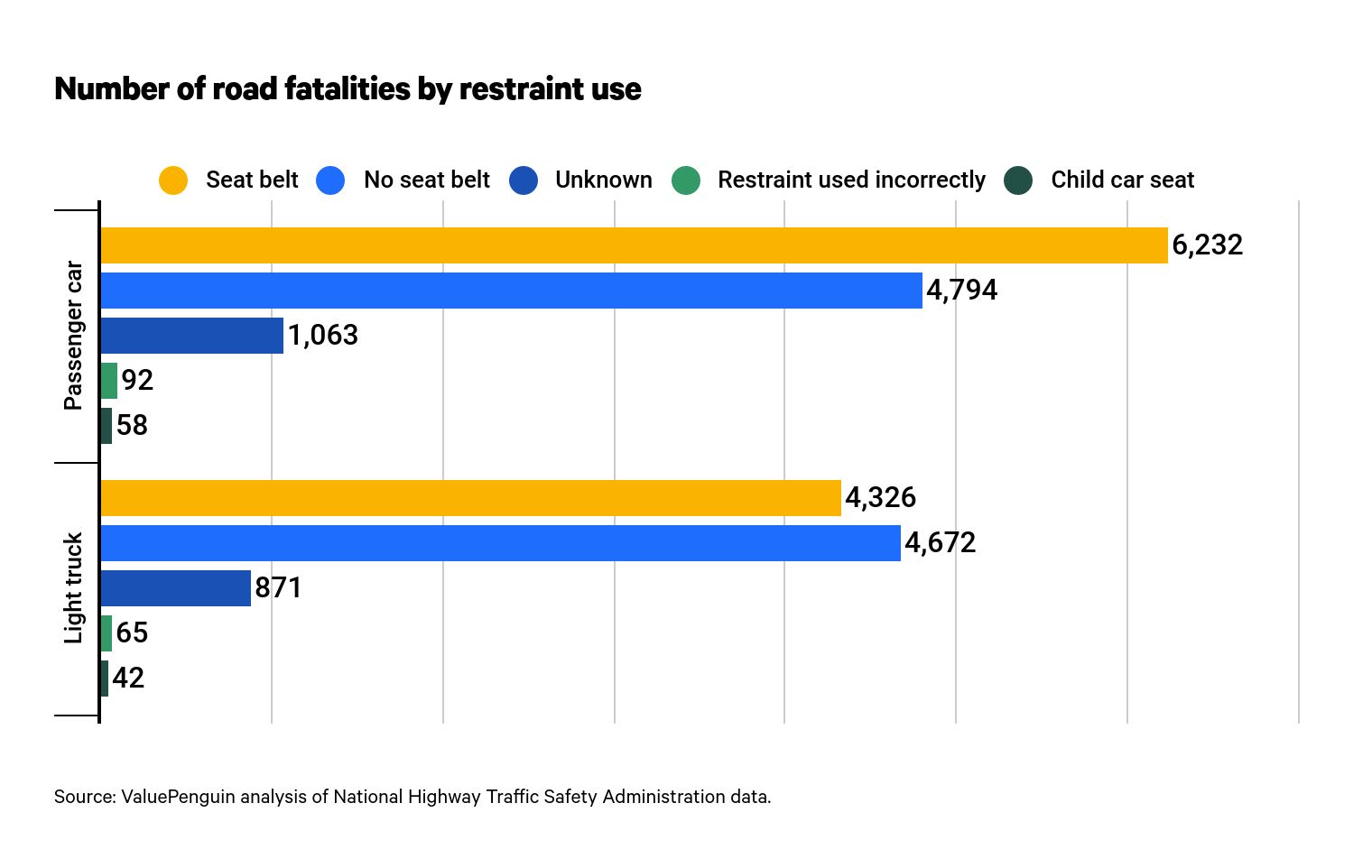
An estimated 14,955 lives were saved by seat belts in 2017, according to the most recently available data. Since 1975, an estimated 374,376 lives have been saved by seat belts. The high point was 15,688 in 2005.
Chances of an injury without a seat belt
In contrast to deaths, only 4% of drivers and passengers injured in vehicle accidents weren’t wearing seat belts. That being said, restraint use is determined by police, so drivers and passengers might underreport this.
Passenger car | Light truck | Total | |
|---|---|---|---|
| Seat belt | 82% | 79% | 81% |
| Child car seat | 2% | 2% | 2% |
| Belt or seat used incorrectly | 1% | 2% | 1% |
| No seat belt | 4% | 5% | 4% |
| Unknown | 11% | 13% | 12% |
| Total injuries (thousands) | 1,500 | 950 | 2,450 |
How many lives do seat belts save each year?
The number of lives that experts say have been saved by seat belts has risen steadily over the past four-plus decades, with the most recent number at 14,955 in 2017. Still, experts believe that 2,549 more lives could have been saved in that same year with proper safety belt usage.
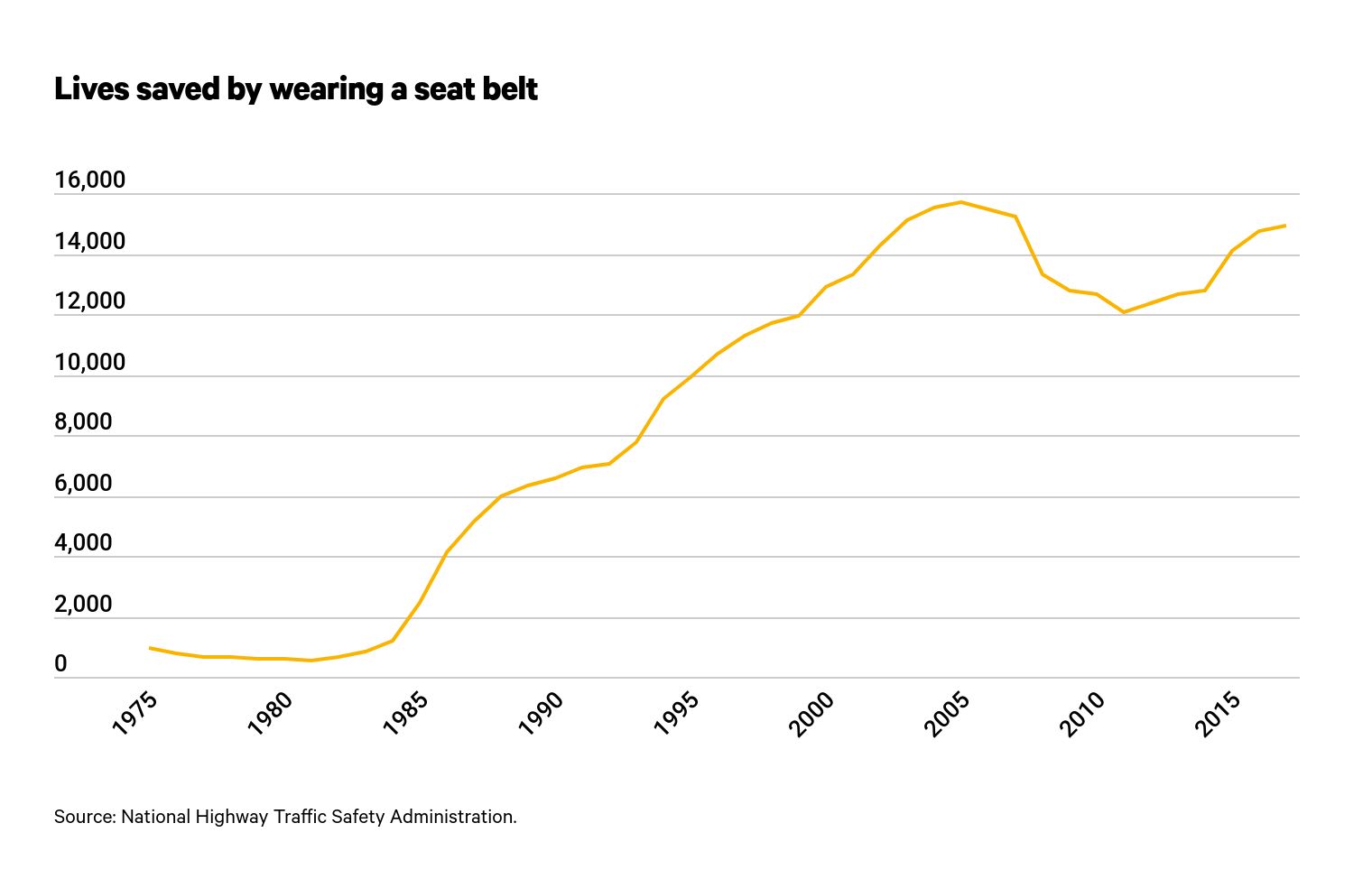
Year | Lives saved by wearing a seat belt | Lives that would have been saved by wearing a seat belt |
|---|---|---|
| 2017 | 14,955 | 2,549 |
| 2016 | 14,753 | 2,471 |
| 2015 | 14,062 | 2,715 |
| 2014 | 12,801 | 2,877 |
| 2013 | 12,644 | 2,771 |
Seat belt statistics by age
Young drivers and young passengers in the front seat are less likely to use their seat belts than older ones. Drivers ages 18 to 24 are more likely to wear a seat belt if they have any passengers outside their age range than if they have passengers all within their age range or no passengers at all.
Meanwhile, adults sitting in the back seat are more likely not to buckle up. Among drivers ages 25 to 69, 28% of rear-seat passengers aren’t using seat belts.
Drivers age 70 or older and passengers of the same age are most likely to wear their seat belts in the front seat, buckling up 92% of the time. In the back seat, 85% of passengers 70 and older wear their seat belts.
Age range | Front seats | Rear seats |
|---|---|---|
| 8 to 15 | 90% | 89% |
| 16 to 24 | 87% | 79% |
| 25 to 69 | 91% | 72% |
| 70 and older | 92% | 85% |
Seat belt statistics by state
New Hampshire drivers and passengers use their seat belts less than their counterparts in any other state — 71% of the time. South Dakota and Wyoming are the only other states below 80%.
Rank | State | Seat belt usage rate |
|---|---|---|
| 1 | New Hampshire | 71% |
| 2 | South Dakota | 75% |
| 3 | Wyoming | 78% |
| 4 | Mississippi | 81% |
| 5 | Massachusetts | 82% |
| 5 | Arkansas | 82% |
| 7 | North Dakota | 84% |
| 8 | Oklahoma | 85% |
| 8 | Kansas | 85% |
| 8 | Virginia | 85% |
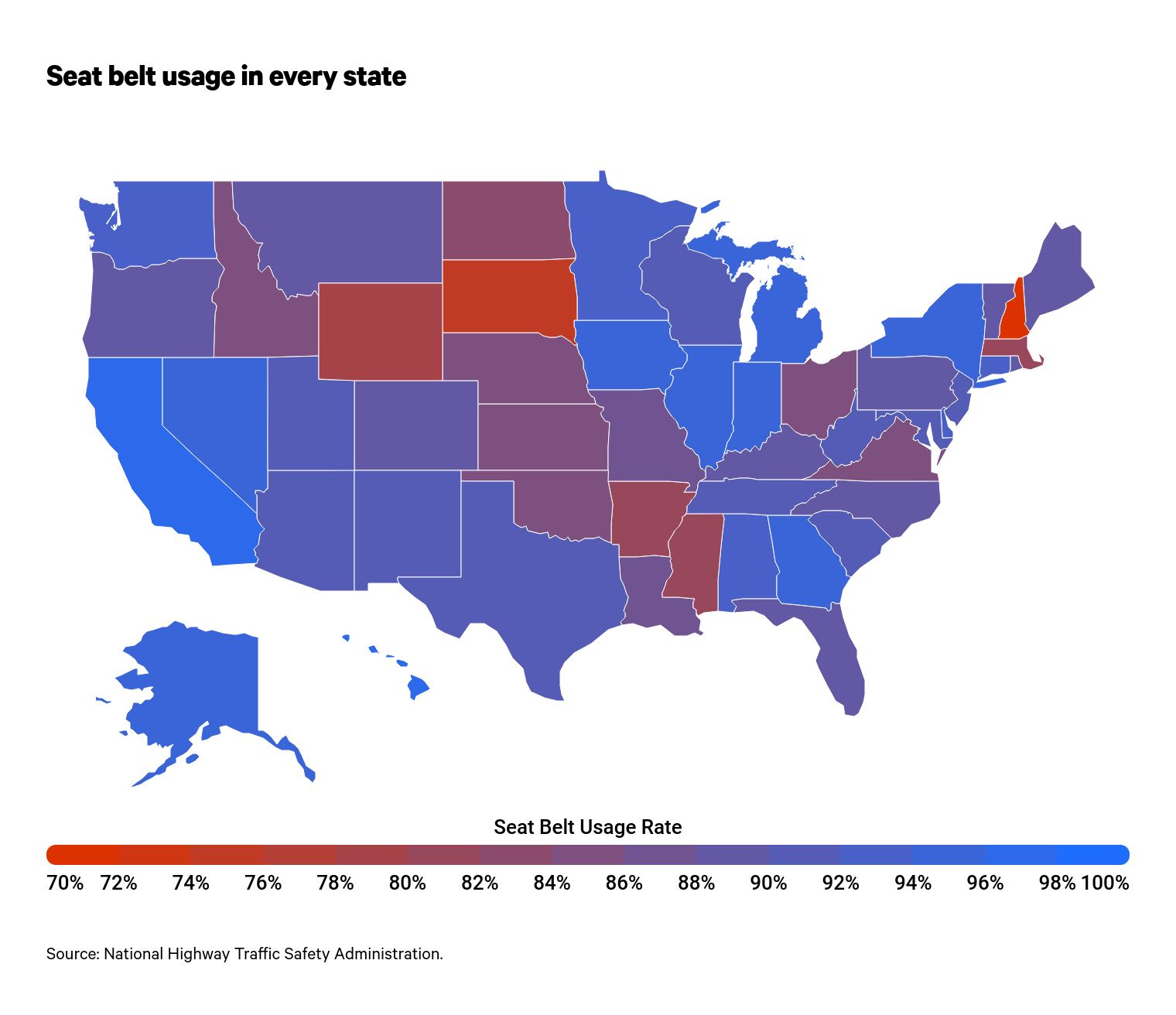
Hawaii, California and Georgia have the highest usage — all 96% or better.
Seat belt usage in every state
Rank | State | Seat belt usage rate |
|---|---|---|
| 1 | Hawaii | 97% |
| 2 | California | 96% |
| 2 | Georgia | 96% |
| 4 | District of Columbia | 95% |
| 4 | Indiana | 95% |
| 4 | Iowa | 95% |
| 7 | Michigan | 94% |
| 7 | Illinois | 94% |
| 7 | Nevada | 94% |
| 7 | New York | 94% |
Car seat statistics
Car seats saved the lives of 325 small children in 2017 — the last year with full data available. In that same year, children in car seats were more than twice as likely to survive a crash if they were correctly strapped in.
Lives saved by child car seats
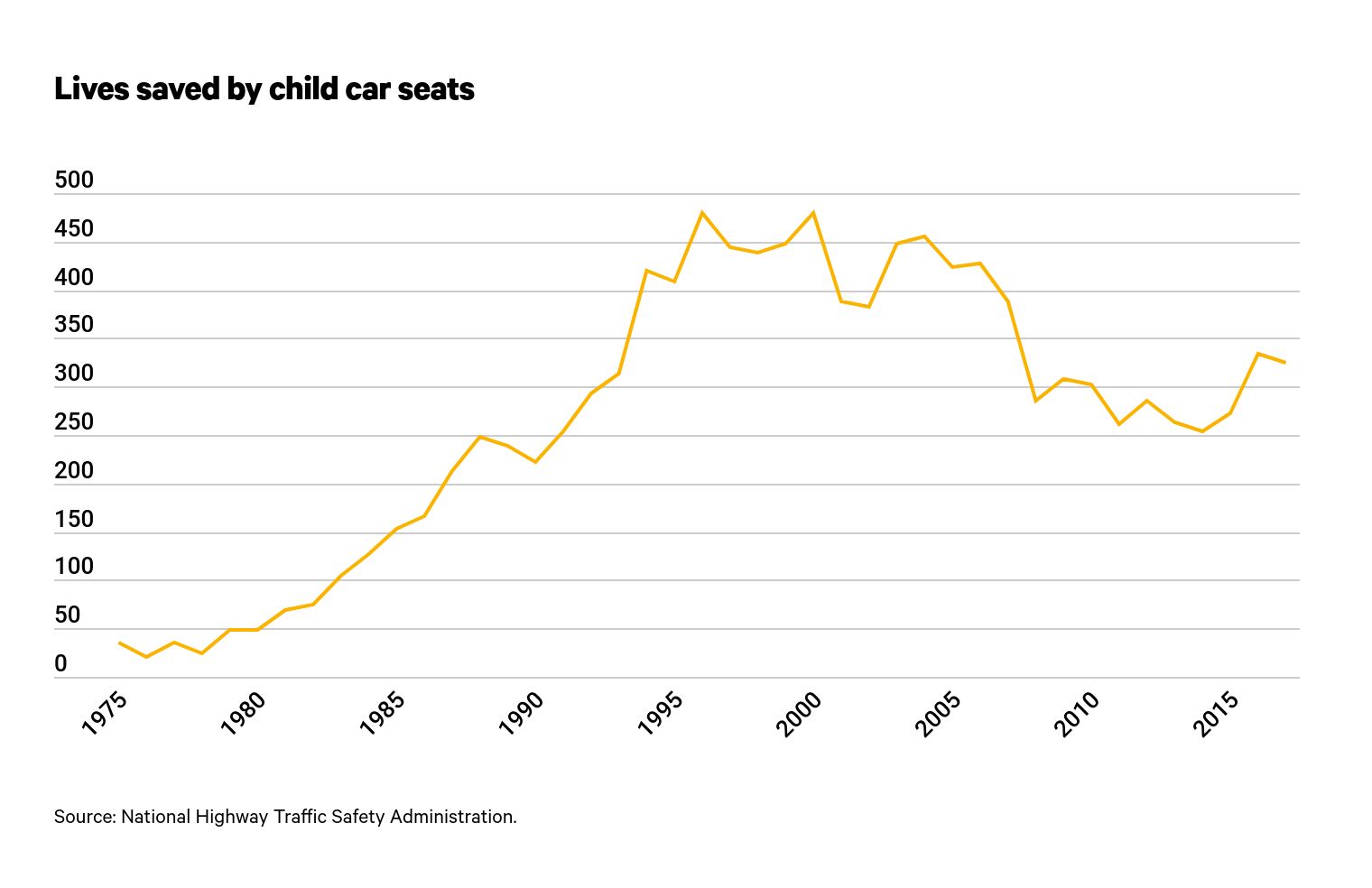
Year | Lives saved by child car seats |
|---|---|
| 2017 | 325 |
| 2016 | 334 |
| 2015 | 273 |
| 2014 | 253 |
| 2013 | 263 |
| 2012 | 285 |
| 2011 | 262 |
| 2010 | 303 |
| 2009 | 307 |
| 2008 | 286 |
Who isn't using car seats for kids?
The drivers least likely to strap kids younger than 8 into car seats are the youngest and the oldest. More than 1 in 10 (11%) drivers between the ages of 16 and 24 aren’t strapping in kids, and the same is true for 9% of drivers older than 70. This compares with 6% of drivers between the ages of 25 and 69.
Unsurprisingly, those who don’t wear seat belts are more likely not to buckle in kids. In fact, a third of those drivers (33%) don't strap their children into car seats.
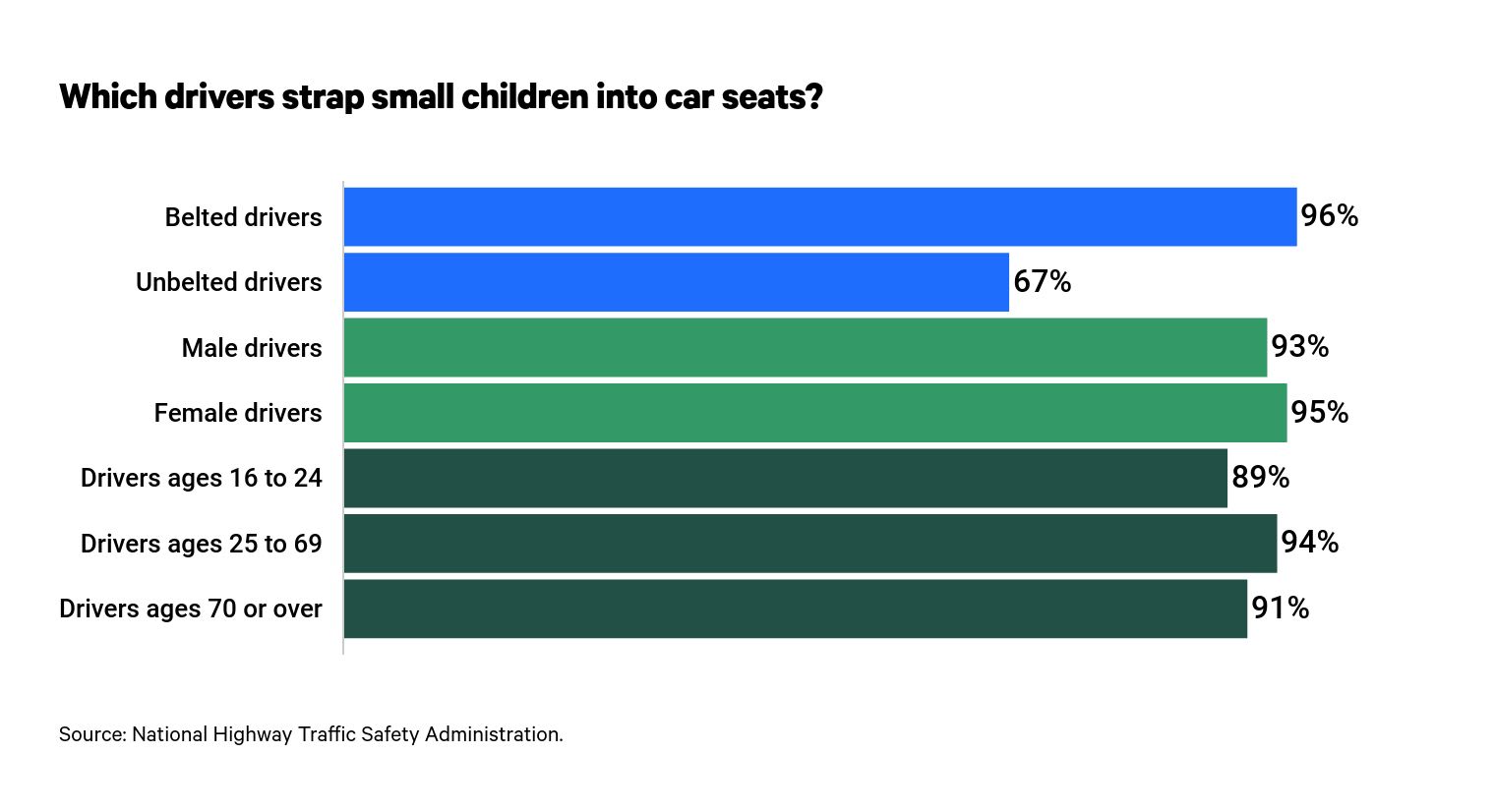
Which drivers strap small children into car seats?
Usage rate | |
|---|---|
| Belted driver | 96% |
| Unbelted driver | 67% |
| Male driver | 93% |
| Female driver | 95% |
| Driver age 16 to 24 | 89% |
| Driver age 25 to 69 | 94% |
| Driver age 70 or over | 91% |
Where are drivers not using car seats?
Drivers are most likely to strap in kids when driving on the freeway or in heavy traffic. In contrast, 12% of drivers don't put kids properly in a car seat in slower traffic, and 21% don't in light traffic.
Driving type/condition | Usage rate |
|---|---|
| Expressway | 96% |
| Heavy traffic | 96% |
| Fast traffic | 95% |
| Medium traffic | 95% |
| Not clear weather conditions | 94% |
| Moderately dense traffic | 94% |
| Clear weather conditions | 94% |
| Surface street | 92% |
| Slow traffic | 88% |
| Light traffic | 79% |
When did seat belts become mandatory?
Although seat belts were patented in 1885 and the modern three-point safety belt was created in 1959 by Volvo, no state mandated they be installed in front seats of new cars until 1961.
- Wisconsin in 1961 was the first state to require that cars' front seats had seat belts.
- The federal government mandated new cars be equipped with seat belts in the front in 1968.
- For a short time, a rule was put in place that technology had to be implemented to prevent cars from starting unless riders were buckled in, but that was quickly overturned.
- New York in 1984 was the first state to require seat belt usage for drivers and passengers in cars' front seats.
How much is a seat belt ticket?
Seat belt fines can be as high as $200, depending on the state in which you’re ticketed. Texas has the highest penalty, which includes court costs. In every state, law enforcement can assess some kind of fine for failure to wear a seat belt.
Here’s a full breakdown from the Governors Highway Safety Association:
State | Maximum fines, fees | Seats enforced | Other details |
|---|---|---|---|
| Alabama | $25 | All seats | Can only be pulled over for front seat violation |
| Alaska | $15 | All seats | - |
| Arizona | $10 | Front seats | Tickets for violators younger than 8 to 15 are for all seats |
| Arkansas | $25 plus court costs and local jail fines | Front seats | - |
| California | $162 | All seats | $20 fine plus $142 in penalties and assessments |
| Colorado | $71 | Front seats | Only people younger than 18 can be pulled over for a violation |
| Connecticut | $120 for violators older than 18 | Front seats | $75 fine plus $10 fee plus $35 surcharge; $92 for minors ($50 fine plus $7 fee plus $35 surcharge) |
| Delaware | $25 | All seats | - |
| District of Columbia | $50 | All seats | - |
| Florida | $30 | Front seats | Tickets for violators younger than ages 6 to 17 are for all seats |
Governors Highway Safety Association data, updated June 2019.
In 35 states, a driver can be pulled over for not wearing a seat belt. In certain other states, drivers can still be ticketed for not buckling up, but only in the course of being pulled over for something else.
Is a seat belt or car seat ticket a moving violation?
In the strictest sense, a seat belt ticket is a moving violation because it violates the law while the car is moving. However, it’s not related to the operation of a car and won’t generally add points to your license.
Some states, such as Illinois, will assess license points for a seat belt violation. Others assess points for minors failing to buckle up or failing to secure children in car seats properly.
Does a seat belt violation affect insurance?
A seat belt violation can affect your insurance, but it depends on how your insurer looks at the infraction. Some insurers won’t raise rates, while we found at least one insurer that more than doubled rates.
We found the largest insurers in the six largest states in the U.S. raised rates an average of 13%. Insurers in the majority of those states raised rates less than 10%, while California insurers bumped rates an average of 41%.
State | Increase in rate with seat belt ticket |
|---|---|
| California | 41% |
| Illinois | 17% |
| Florida | 8% |
| Texas | 4% |
| New York | 4% |
| Pennsylvania | 4% |
It's also important to note that this can happen in states that don’t use a license point system.
Sources and methodology
We collected information and data from the following sources, as well as DMV and department of transportation sites for several states:
ValuePenguin's analysis of the impact of seat belt violations on insurance used rate data from Quadrant Information Services. These rates were publicly sourced from insurer filings and should be used for comparative purposes only, as your quotes may differ.
Editorial Note: The content of this article is based on the author's opinions and recommendations alone. It has not been previewed, commissioned or otherwise endorsed by any of our network partners.
